So, Gigabyte and AMD sent us a few toys recently...

This is the new Gigabyte motherboard designed for the AMD FM2 A10 series of CPUs. We don't hear as much from AMD these days as we do Intel, especially at our events, so we were excited at the prospect of seeing what they're up to. AMD are pitching their Trinity platform, which is their integrated APU with graphics support and their A85X chipset platform.
 The A10 APU.
The A10 APU.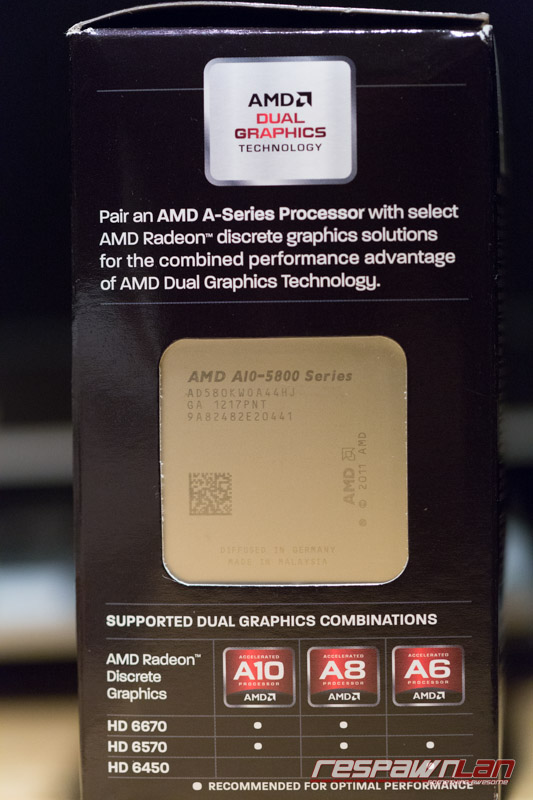
Looking at the features and specifications of the AMD A10 CPU, we can see that it's not only geared for value performance but with a high quality GPU, multiple display support and full DirectX 11 support, they really want to get high end multimedia features to customers without the price premiums associated with it. Think video encoding, media playback along with a healthy dose of gaming. Don't expect this to break any records for speed - discrete graphics will rule the roost there, but an integrated graphics processor has some very big advantages: namely, it keeps the cost of the system build cost lower and will typically result in lower power consumption - both very good things if you're on a budget.
The ATI Radeon 7660D IGP.The concept of the A10 "Advanced Processing Unit" is simple; it integrates both the CPU and GPU into one. Intel do this already with their Core i3/i5/i7 series CPUs. AMD's strategy is to include a full Radeon GPU inside the CPU with all the features of a full-sized Radeon card. In the A10 CPU's case, AMD are including what they call a Radeon 7660D.
This includes EyeFinity, video hardware decoding offload technologies including AMD's Picture Perfect and Video Encode and Decoding, DisplayPort 1.2 and on A85X motherboards, AMD CrossFire and Dual Graphics are both supported. It even uses the same Radeon driver set so those who are familiar with AMD's Catalyst Control Centre will be comfortable.
Having all these features in an "integrated" graphics solution is great for budget PCs where ordinarily, you'd get slugged the extra $50-100 to get a dedicated GPU while your CPU's integrated GPU engine sits idle.
This APU's graphics engine supports three DisplayPort or DVI/HDMI displays along with VGA as well, should you require it.
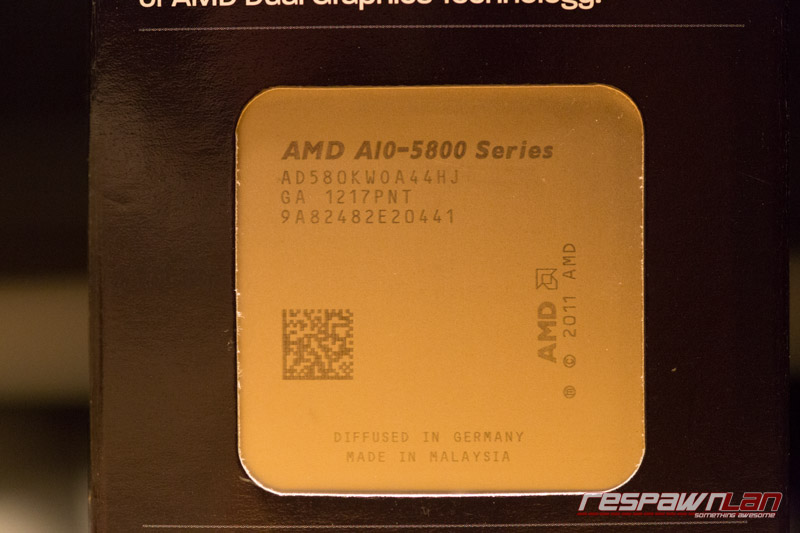
Things get even pretty awesome from here - if you pair this APU with an A85X chipset, you have the option of adding a second GPU for what AMD call "Dual Graphics" support, enabling both the APU and the discrete graphics to work together to increase performance. AMD recommend a Radeon HD 6670 or 6570 to run alongside the A10 - but AMD suggest you plug the displays into the discrete graphics for a small performance boost over the integrated. So a 6670 paired with an A10 will give you a greater combined performance than, say, running a 6670 with an Intel Core i3. AMD are claiming the difference in 3DMark 11 on their test system was 840 vs. 572 with a single GPU.
This gives customers a great way to upgrade their systems and still make use of the hardware they've already bought.
The CPU bits
AMD shipped us the creme of the crop, A10-5800K CPU. Those familiar with Intel terminology will recognise the 'K' at the end of the SKU product ID - this, like the Intel chip, designates the unlocked nature of the chip. So we'll give it a bit of a test to see if it can overclock nicely.
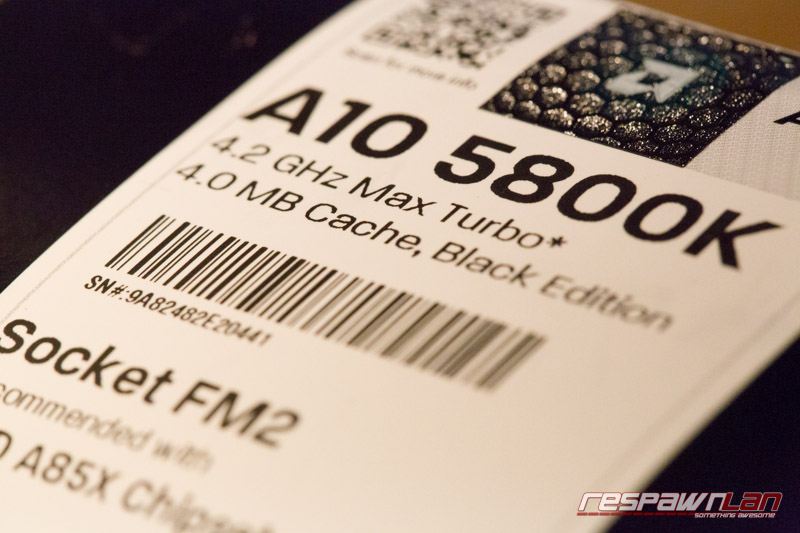
For CPU clocks, we're looking at a 3.GHz CPU which has a feature called Turbo Core 3.0. This enables the CPU cores to be independently clocked to 4.2GHz in bursts to improve system performance. Intel's solution is SpeedStep. Turbo Core's advantage here is that it works not only independently on a per-core basis but also shares logic with the GPU component, so if you're hitting your CPU hard while the GPU sits idle, you'll gain the benefit of a speed increase as a result. The same applies for GPU intensive tasks; the CPU will see a power decrease so your system will give you the best performance from that power.
DDR3 1866MHz memory is the minimum recommended for this APU but they suggest to run up to 2400MHz. This is very important to get the best possible performance out of the integrated Radeon 7660D graphics as the GPU component shares the same memory.
The Gigabyte A85X motherboard.
The motherboard shares a similar package design to the Thunderbolt board we reviewed earlier, along with the touted
Ultra Durable 5 technology which we're a fan of. This means lower power through more efficient IR3550 voltage regulators - smaller heatsinks, less heat dissipation, meaning an extended life for your components, quieter cooling and less cost of powering your system. We are also reminded of the usual array of Gigabyte features we'd expect to see on an enthusiast board - Their Windows based @BIOS flasher, EasyTune software for over clocking, ON/OFF charge, allowing you to charge high power USB devices such as iPhones when the system is switched off, "3TB+ Unlock" to allow 3TB HDDs to be used when it's running in BIOS mode.
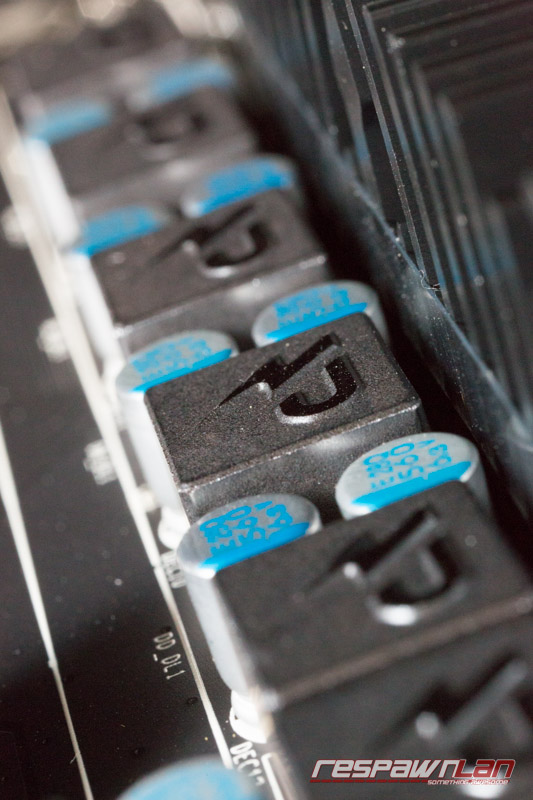
The BIOS supports EFI booting and claims to recommend Windows 8. Bring it on, we say. Windows 8 it is.
It's clear that we're not looking at a low end board here and the A10 APU puzzle is complete - it has previously been common to only find lower end boards available for the budget end of the market.
This board is based on the A85X chipset incorporating their latest FCH, or "Fusion Controller Hub". This is where you will find integrated gigabit ethernet, 8 channels of 6Gbit/sec SATA with RAID, four USB3 ports and 10 USB2 ports supported and a VGA DAC for yet another display output totalling four display outputs.
We have an on-off switch on the board along with a diagnostic readout - invaluable for system tweakers and overclockers - and of course, our eyes light up in Respawn labs whenever we see something nice like this. It makes us happy. Hardware manufactures: please do this. We like to be happy. We've also got a clear CMOS button right next to it. These are premium features we'd expect only to see on high end boards geared for overclocking so we're pleasantly surprised to see the care taken here.

Cracking open the box, we see Gigabyte's minimalistic packaging. We see the basics are included; six black SATA cables with right-angle connectors on one end and clips, manuals, a CD and an ATX rear plate for your case.

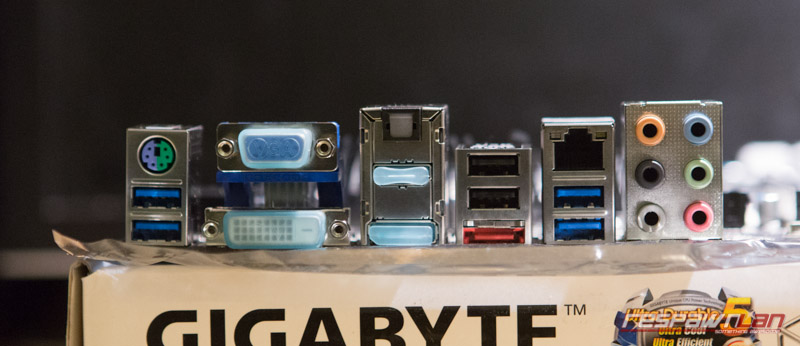
On the backplate, we have eSATA, multichannel audio output, 4x USB 3, 4x USB 2, DVI, VGA, DisplayPort and HDMI, plus a combined PS2 keyboard/mouse connector for those who like to live in the dark ages with their model M keyboards - Gigabyte have not forgotten about you here. The DVI socket supports Dual-Link displays for up to 2560x1600 but beware - you can't run a VGA display off the DVI, even with an adapter - it's DVI-D (digital) only. So you're limited to only one VGA display which must be connected to the D-Sub port.
2 of those USB3 ports are powered from the integrated A85X FCH, two of them come from a third party Eltron EJ168 controller. The addition of extra USB3 ports here is something we'd expect only in premium A85X boards - we'd expect some manufacturers will keep the costs down by omitting this step.
Pay attention to the "Keyboard/Mouse" icon on the motherboard's USB ports. If you are running Windows 7 or earlier, you can almost guarantee you will have issues with the USB3 ports before installing an OS.Gigabyte also state that the DisplayPort socket doesn't support hot plugging - so you'll need to turn your system off before connecting or disconnecting a DisplayPort device.
PCI-Express slot limitationsThe board itself features three 16 lane PCI-Express 2.0 slots, three x1 and one PCI 32bit. While we don't believe this'll negatively impact performance for many uses, those who are planning on connecting high performance RAID controllers or 10GbE controllers will need to pay attention, especially as a system like the A10 looks great for a homebrew NAS system. There are some limitations, normal for motherboards in the low to mid range category, which may limit the performance:
- If the first x16 slot is used, you can use all 16 lanes.
- If the second x16 slot is used as well as the first, the first and second slots only get 8 lanes each.
- The third "x16" slot only has four lanes to it so you'll likely use this for a RAID card or 10 Gigabit Ethernet controller. If this slot is used as well as the third PCI Express x1 slot, then this slot will run only in single lane mode.
Phew! So the summary is:
1. If you are using a graphics card, put it in the first x16 slot.
2. If you are using two graphics cards or a card that must absolutely get 8 lanes, then put them in the first and second slot.
3. If you plan on using the third x16 slot (which only operates at 4x), don't use the third x1 slot unless you need to and can suffer the performance hit.
The board itself looks very similar to the Z77 board we reviewed in terms of design. We see the same premium black/grey design along with very minimalistic heatsinks and black connectors. No electrolytic capacitors are present, which is the norm these days. Thanks to the IOR's PowIRstage IR3550s, we get that same low heat/high efficiency power regulation - a premium feature we'd expect to see on high end systems.

The Realtek ALC892 codec is fairly standard for integrated audio on motherboards and we see it here, supporting up to 7.1 channel analog output with SPDIF digital. Those who wish to connect a recent AV amplifier will be able to output audio via the HDMI or to a display via DisplayPort.
Internal connectivity includes 7 SATA ports on the board and one eSATA. An additional 2 USB 3.0 ports are available on a header connector for use with a USB3 enabled PC case and 8 USB 2.0 for the same.

Gigabit Ethernet is supplied via an onboard Realtek NIC. The good news is that this NIC is supported under many OSís so you should expect the ethernet controller to work from the moment you first install an OS, enabling you to hit the Internet straight away for driver installation.
Firing it up
So we put the CPU and RAM in plugged a SATA hard drive in and an optical drive and turned the system on.
The first thing we noticed is that the CPU fan started spinning. Then, it stopped.
Panic. Did we just kill the review board??! Oh man, we're in trouble now!
But we soon learned that this was expected behaviour and party of the system's regular startup sequence.
Gigabyte have given this board the same Hybrid EFI 3D DualBIOS system that we've seen before and we like it. So after a quick fiddle around with some settings, we booted up off a Windows 8 DVD and we noticed that instead of the Windows 8 logo, we saw the Gigabyte full screen BIOS logo instead while Windows booted from the DVD.
We were mistakenly confused by this the first time; did the board just POST again?
This does, however, look like a quirk with the way EFI works with this board. We didn't observe it with the Z77 board we reviewed earlier but we hadn't tested Windows 8 on this system.
If you're booting with Windows 8, expect this thing to work out of the box! Plug this into the net and you have a fresh system you can download drivers directly from the Gigabyte website from without having to insert the CD.
The Windows 7 experience was, however, a little bit more backward - and the OS was picky about which USB sockets we used as the newer USB3 ones were unsupported by the base OS and would not correctly identify the presence of a keyboard or mouse in the system, making the install a little challenging.
Performance.Performance testing is still being conducted - but we have to say, this thing does a very decent job.
The A10, for the price point, is in the same league as Intel's i3. Things start to look very bad for Intel in the value segment with their dual-core processor and graphics that just doesn't stack up to the IGP performance of the A10. i3 buyers who want more GPU grunt will need to package discrete graphics into their system while the integrated graphics logic in the i3 sits idle.
ConclusionThis thing won't win any awards for being a top performer. What it will do, however, is become a recommendation for those who want to build a system on a budget, yet still have a premium motherboard and good quality integrated graphics. Uni students, high school students - or anyone who has given us the "my PC is too old to take to a LAN party" excuse, this is the basis of your next system.
We are glad to see that Gigabyte have put the resources in to designing a good quality motherboard to support the A10 APU. It is often assumed that quality motherboard feature sets only belong with higher performance processor platforms; Gigabyte's interest and commitment to the FM2 platform with this product is the other half of the story and why we'd recommend a system build with this processor.















